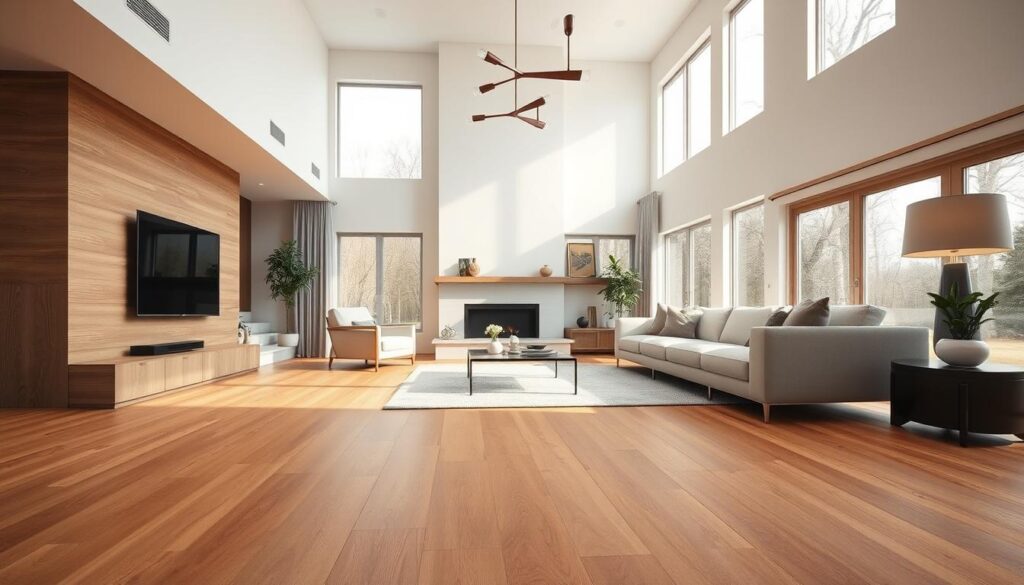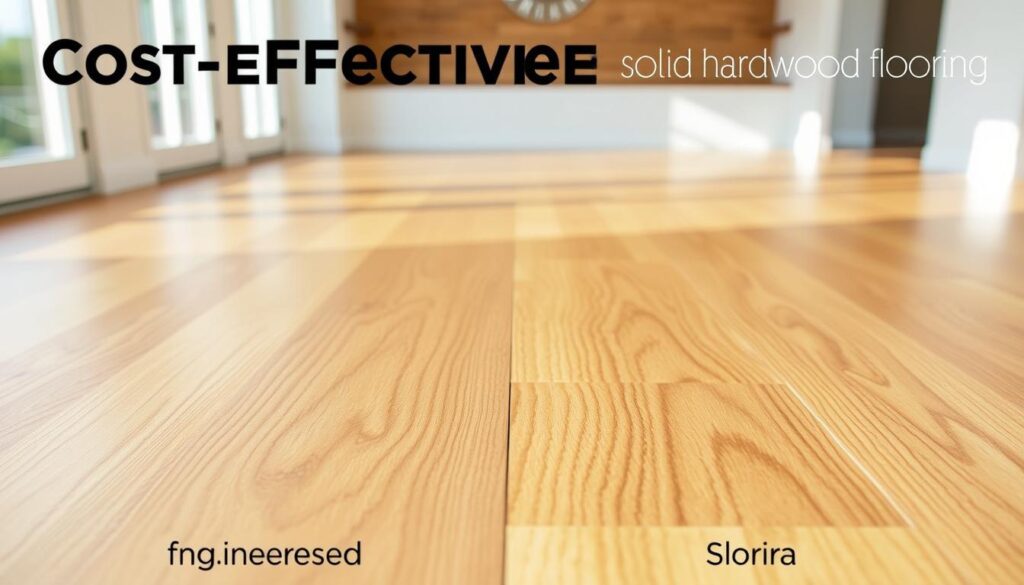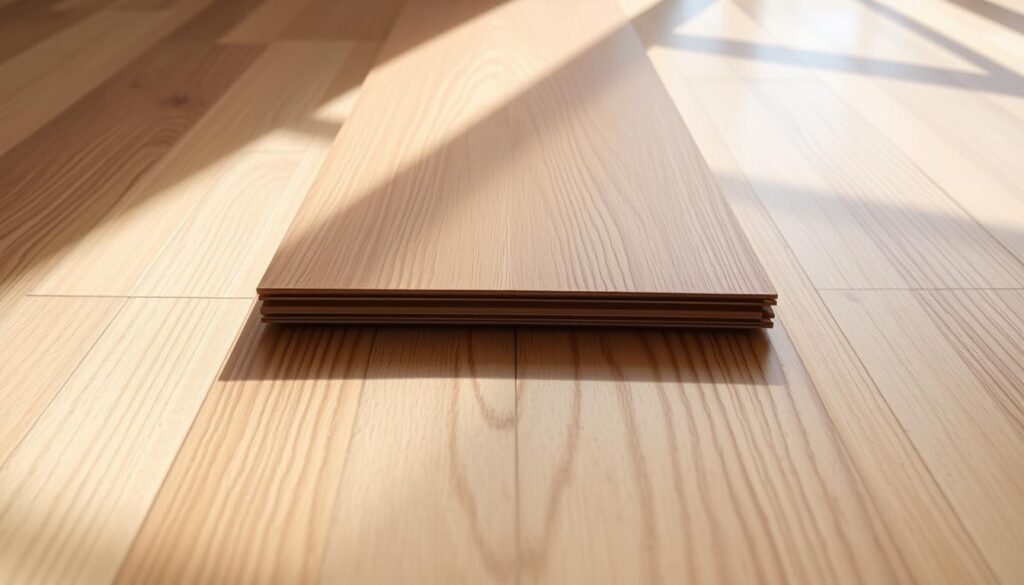Discover the top 5 benefits of engineered red oak flooring for your home. Durable, beautiful, and easy to maintain.
Engineered red oak flooring is becoming more popular in the US. It offers a mix of beauty and practicality. This flooring combines the classic look of red oak with modern engineering.
The natural grain patterns and rich tones of red oak floors add timeless beauty to any home. Unlike solid hardwood, engineered red oak is stable in changing humidity and temperature. This is great for busy homes.

Today, you can find engineered red oak flooring in many finishes, widths, and grades. It suits every taste and budget. Whether you prefer rustic or refined, these floors offer the authentic look of hardwood with practical benefits.
The way engineered red oak is made makes it less likely to warp or cup. This is perfect for areas with moisture, like basements or kitchens. It still brings the warmth and charm of hardwood flooring.
Key Takeaways
- Engineered red oak flooring combines beauty with practical stability
- Can be installed in areas where solid hardwood isn’t recommended
- Offers multiple installation methods to suit different situations
- More cost-effective than solid hardwood options
- Uses less hardwood resources for greater environmental sustainability
- Maintains the authentic look and feel of traditional oak floors
- Available in various finishes to match any home décor style
What Is Engineered Red Oak Flooring?
Engineered red oak flooring is a mix of beauty and smart design. It has real red oak on top and layers of wood underneath.
The Structure of Engineered Wood Flooring
Engineered wood has three to nine layers. These layers are plywood or fiberboard, arranged in opposite directions. This design helps it handle changes in humidity better.
Red Oak as a Veneer Choice
The top layer of engineered flooring is red oak veneer. It has unique grain patterns and colors ranging from pink to reddish-brown. Red oak is also durable, ranking 1290 on the Janka hardness scale.
How It Differs from Solid Hardwood
There are key differences between engineered and solid hardwood:
- Thickness: Solid hardwood is ¾ inch thick, while engineered is ⅜ to ½ inch
- Stability: Engineered flooring doesn’t warp as much in humid conditions
- Installation: Engineered floors can go in basements and over concrete, unlike solid wood
- Refinishing: Solid hardwood can be refinished many times, but engineered flooring usually allows 1-3 refinishing cycles
Choosing between engineered and solid hardwood depends on your needs. Engineered red oak offers beauty and is more stable and versatile for installation.
Durability and Stability: The First Major Benefit
Engineered red oak flooring has a special design that makes it very stable. It doesn’t expand or shrink much with changes in humidity. This makes it great for tricky spots in your home.
Its layered structure helps it stay strong and straight, even in wet places like kitchens and bathrooms. This is because each layer is set at a right angle to the others.
Video source from Youtube
It’s also good for areas with radiant heating because it doesn’t warp or buckle. Solid hardwood might not do as well in these conditions.
With the right care, engineered red oak flooring can last 20-30 years. The thickness of the top layer is key. Thicker layers mean you can refinish it more times, just like solid hardwood.
- Perfect for below-grade installations like finished basements
- Ideal for humid environments where solid wood would suffer damage
- Maintains integrity over concrete subfloors
- Resists dimensional changes during seasonal transitions
Choosing durable wood flooring means less need for replacements and repairs. Homeowners love knowing their floors will look great for years, even in tough conditions.
Versatile Installation Options for Every Home
Engineered red oak flooring is great because it can be installed in many ways. It fits well with different subfloors, skill levels, and room conditions. This is unlike traditional hardwood, which has fewer options.
Floating Floor Installation
Floating wood floors are easy for most homeowners to set up. This method connects planks to each other, not the subfloor. The planks have edges that click together, making a tight surface that floats over the floor.
This method is perfect for DIY projects. It works well over concrete, vinyl, or tile floors. You need minimal tools and some skill to do it yourself.
Glue-Down Method
Glue-down flooring is great for busy areas. It uses special adhesives to stick planks to the subfloor. This makes a solid floor that reduces noise and moves less.
It’s best for rooms with radiant heating or where temperatures change a lot. Glue-down floors transfer heat well and stay stable. For the best results, it’s usually better to have a pro install it.
Nail-Down Applications
Nail-down hardwood is a traditional way to install engineered planks. It uses cleats or staples to attach flooring to wood subfloors. This method allows the floor to expand and contract naturally.
Engineered planks need fewer fasteners than solid wood, making installation quicker. This method is best for upper floors with plywood subfloors. If you’re handy, you can do it yourself with the right tools.
Each installation method has its own benefits. They depend on your subfloor, how you use the room, and your skill level. Engineered red oak is versatile, fitting almost any home. It lets you explore design options that solid hardwood can’t.
Cost-Effectiveness Compared to Solid Hardwood
When choosing flooring, price is a big factor. Engineered red oak is a smart choice for those on a budget. It offers quality floors without breaking the bank.
Initial Purchase Price Advantages
The engineered red oak cost is 20-30% less than solid hardwood. This is because only the top layer is premium red oak. The core uses plywood or fiberboard, which is cheaper.
Entry-level engineered oak starts at $3-5 per square foot. Mid-range options are $5-8. This makes it a very affordable wood flooring option.

Long-Term Value Considerations
Engineered red oak also offers long-term savings. Installation costs are often lower, especially with DIY-friendly options. These value flooring options need less special tools than solid hardwood.
It’s also more stable, reducing warping or cupping in humid places. While solid wood can last over 100 years, engineered flooring lasts 25-40 years. It needs 1-2 refinishing, at a much lower cost. This is a great balance for most homeowners.
The Timeless Beauty of Engineered Red Oak
Engineered red oak flooring brings the real charm of natural wood floors with more design options. It has warm honey tones, from light amber to rich cinnamon. This creates spaces that are both elegant and cozy.
Red oak’s wood grain patterns make each plank special. You’ll see clear rings, subtle rays, and a straight, coarse texture. This adds depth to any room. Unlike other woods, red oak’s grain catches light in unique ways.
The engineered design lets for wider planks than solid hardwood. This shows off the wood grain patterns better. Wide planks give a modern look while keeping the natural beauty of classic wood flooring.
| Finish Type | Effect on Red Oak Aesthetics | Design Compatibility |
|---|---|---|
| Natural Clear Coat | Preserves authentic color variation and grain clarity | Versatile, suits traditional and modern spaces |
| Light Stains | Brightens spaces while highlighting grain detail | Perfect for coastal, Scandinavian, and farmhouse styles |
| Medium Brown Stains | Enhances warmth and depth of natural patterns | Ideal for traditional, craftsman, and transitional homes |
Red oak’s beauty fits many decor styles, from traditional to modern. Its neutral tones work well with different colors and furniture. This is why red oak has been a key part of American homes for so long.
Environmental Benefits and Sustainability
More homeowners want wood floors that are good for the planet and look great. Engineered red oak flooring is a top choice because it’s both eco-friendly and stylish.
Efficient Use of Hardwood Resources
Engineered flooring uses wood more efficiently. One tree can make up to four times more engineered flooring than solid wood. This makes engineered red oak a green choice, helping save forests and meet demand.
Lower Carbon Footprint
Engineered red oak makes less waste and needs fewer materials than solid wood. Its core layers might use fast-growing trees or recycled wood. This reduces emissions from transport and lowers environmental harm.
Indoor Air Quality Considerations
Choose engineered flooring with low VOCs to improve indoor air. Look for products with little formaldehyde and meet strict air quality standards. Check for these certifications:
- Forest Stewardship Council (FSC) certification
- CARB Phase 2 compliance
- FloorScore certification
- GreenGuard Gold standards
These ensure your wood floors are healthy for your home and support green forests. The best engineered red oak combines strength with green benefits, offering beauty without harming the planet.
Maintenance Tips for Engineered Red Oak Flooring
Proper care keeps your engineered red oak floors looking great for years. Unlike some floors, engineered ones are easy to maintain. They offer beauty without needing too much upkeep.
Daily Cleaning Practices
Start by using a microfiber dust mop every day. This keeps your floor scratch-free. For weekly cleaning, use a damp microfiber mop with a cleaner made for wood floors. Stay away from steam cleaners and oil-based products to avoid damage.
Handling Spills and Stains
Act fast when spills happen. Use a cloth to blot them, not wipe. For sticky spots, a damp cloth followed by drying is best. Remove scuff marks with a soft eraser or wood floor cleaner. For pet accidents, use enzyme-based cleaners to avoid damage.
Refinishing Possibilities
Refinishing depends on your floor’s wear layer thickness. Floors with 3mm or thicker layers can be sanded and refinished 2-3 times. Thinner layers might need screen and recoat instead. Most floors need refinishing every 7-10 years with regular use.
- Use felt pads under furniture to prevent scratches
- Place area rugs in high-traffic zones
- Maintain indoor humidity between 35-55%
- Trim pet nails regularly to minimize surface damage
- Clean with products specifically designed for wood floors
How to Choose Quality Engineered Red Oak Products
Choosing the right wood flooring involves looking at several key factors. When picking engineered hardwood, the wear layer thickness is crucial. Look for products with 2mm to 4mm thick top layers. These allow for future refinishing and last longer.

The core of the flooring also matters a lot. Plywood cores are more stable in different humidity levels than HDF cores. Top brands use 7-11 layers of plywood for the best stability.
Here are the main things to check when looking at products:
- Finish quality (aluminum oxide or UV-cured polyurethane)
- Edge milling precision
- Layer adhesion integrity
- Board straightness
- Surface finish consistency
| Wear Layer Thickness | Refinishing Potential | Ideal Application |
|---|---|---|
| 1-2mm | 0-1 times | Lower traffic areas, rentals |
| 3mm | 1-2 times | Residential, medium traffic |
| 4mm+ | 2-3 times | High traffic, long-term investment |
Buy from specialty flooring stores for better advice and quality. Take samples home to see how they look in your space. Warranties of 25-50 years show the manufacturer’s trust in their products.
Popular Design Styles Using Red Oak Floors
Red oak interior design is very versatile. It fits well with many home styles. It brings together classic charm and modern appeal, making it popular in American homes.
Traditional American Homes
In styles like Colonial, Craftsman, and farmhouse, red oak floors are timeless. They use medium-width planks with warm stains. This highlights the wood’s natural grain.
Red oak looks great with wooden beams, antique furniture, and neutral walls. It defines traditional spaces beautifully.
Modern Minimalist Spaces
Red oak also fits well in modern, sleek spaces. The latest trends show it with light finishes in wider planks. These floors add warmth to spaces with clean lines and few pieces of furniture.
Transitional Design Applications
Transitional spaces mix old and new. Red oak is perfect here, balancing classic and modern. It’s used in:
- Herringbone patterns with medium-tone stains
- Mixed-width planks for visual interest
- Custom gray-brown finishes that match many colors
| Design Style | Ideal Plank Width | Popular Finishes | Pattern Options |
|---|---|---|---|
| Traditional | 2-4 inches | Medium to dark stains | Straight lay, diagonal |
| Modern | 5-7+ inches | Natural, white, gray | Wide plank, straight lay |
| Transitional | Mixed widths | Medium with gray undertones | Herringbone, chevron |
Conclusion: Why Engineered Red Oak Might Be Right for Your Home
Engineered red oak flooring is a great choice for many homeowners. It’s stable, easy to install, and costs less than solid hardwood. Plus, it looks beautiful and is good for the environment.
Thinking about the best flooring for your home? Engineered red oak is a top pick. It works well in different homes, is easy to care for, and can be refinished many times. This makes it a smart choice for the long run.
Choosing engineered red oak depends on your needs and style. But, it’s known for being durable, flexible, and stylish. It’s a great option to make your home look and feel better.
FAQ
What is the structure of engineered red oak flooring?
Engineered red oak flooring has layers. It starts with a plywood or HDF core. Then, a real red oak wood veneer is added on top. This design makes it more stable and less prone to warping than solid hardwood.
How does engineered red oak differ from solid hardwood flooring?
Engineered red oak and solid hardwood flooring differ in how they’re made and installed. Engineered flooring uses less premium hardwood, making it cheaper. It’s also more stable and can be installed in more ways.
What are the main benefits of engineered red oak flooring?
Engineered red oak flooring is durable and stable. It’s easy to install and cost-effective. It also looks timeless and is good for the environment because it uses hardwood more efficiently.
Can engineered red oak flooring be refinished?
Yes, engineered red oak flooring can be refinished. How many times it can be done depends on the wear layer’s thickness. Thicker layers allow for more refinishes over time.
What are the different installation methods for engineered red oak flooring?
Engineered red oak flooring can be installed in several ways. You can use a floating floor, glue it down, or nail it in place. These options make it suitable for many homes and subfloors.
How does the cost of engineered red oak compare to solid hardwood?
Engineered red oak flooring is cheaper than solid hardwood at first. It also might cost less to install. This makes it a smart choice for those looking for value and durability.
What design styles work well with engineered red oak flooring?
Engineered red oak flooring fits many design styles. It works well in traditional homes, modern spaces, and transitional decor. Its warm tones and versatile finishes make it easy to match with different designs.
How do I choose quality engineered red oak flooring products?
To pick quality engineered red oak flooring, look for thick wear layers and durable construction. Check for reputable warranties from the manufacturer. Comparing prices and features will help you find the best value.
Read also : 4 Inch Hardwood Flooring: What You Need to Know
